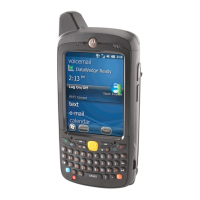DataWedge to send output data to any foreground application other than applications associated with user-defined
profiles when Profile0 is enabled.
Profile0 can be disabled to allow DataWedge to only send output data to those applications which are associated in
user-defined profiles. For example, create a profile associating a specific application, disable Profile0 and then scan.
DataWedge only sends data to the application specified in the user-created profile. This adds additional security to
DataWedge enabling the sending of data only to specified applications.
Plug-ins
A plug-in is a software module utilized in DataWedge to extend its functionality to encompass technologies such as
bar code scanning. The plug-ins can be categorized into three types based on their operations:
• Input Plug-ins
• Output Plug-ins
• Process Plug-ins.
Input Plug-ins
An Input Plug-in supports an input device, such as a bar code scanner contained in, or attached to the device.
DataWedge contains base plug-ins for these input devices.
• Bar Code Scanner Input Plug-in – The Bar Code Scanner Input Plug-in is responsible for reading data from the
integrated bar code scanner and supports different types of bar code readers including laser, imager and internal
camera. Raw data read from the bar code scanner can be processed or formatted using Process Plug-ins as
required. DataWedge has built-in feedback functionality for the bar code scanner to issue user alerts. The
feedback settings can be configured according to user requirement.
• MSR Input Plug-in – The Magnetic Stripe Reader (MSR) Input Plug-in is responsible for reading data from an
MSR. Raw data read from the MSR can be processed or formatted using Process Plug-ins as required.
DataWedge has built-in feedback functionality for the MSR to issue user alerts. The feedback settings can be
configured according to user requirement.
Process Plug-ins
Process Plug-ins are used in DataWedge to manipulate the received data according to the requirement, before
sending to the foreground application via the Output Plug-in.
• Basic Data Formatting Process Plug-in – The Basic Data Formatting Plug-in allows DataWedge to add a prefix
and/or a suffix to the captured data before passing it to an Output Plug-in.
• Advanced Data Formatting Process Plug-in – The Advanced Data Formatting Plug-in allows DataWedge to
apply rules (actions to be performed based on defined criteria) to the data received via an input plug-in before
passing it to an Output Plug-in.
Output Plug-ins
Output Plug-ins are responsible for sending the data from Input Plug-ins to a foreground application on the device.
• Keystroke Output Plug-in – The Keystroke Output Plug-in collects and sends data received from the Input Plug-
in to the foreground applications by emulating keystrokes.
• Intent Output Plug-in – The Intent Output Plug-in collects and sends data received from the Input Plug-ins to
foreground applications using the Android Intent mechanism.
• IP Output Plug-in – The IP Output Plug-in collects and sends data received from the Input Plug-ins to a host
computer via a network connection. Captured data can be sent over an IP network to a specified IP address and
port using either TCP or UDP transport protocols.
DataWedge Configuration | 59
MN000116A02-A | May 2015

